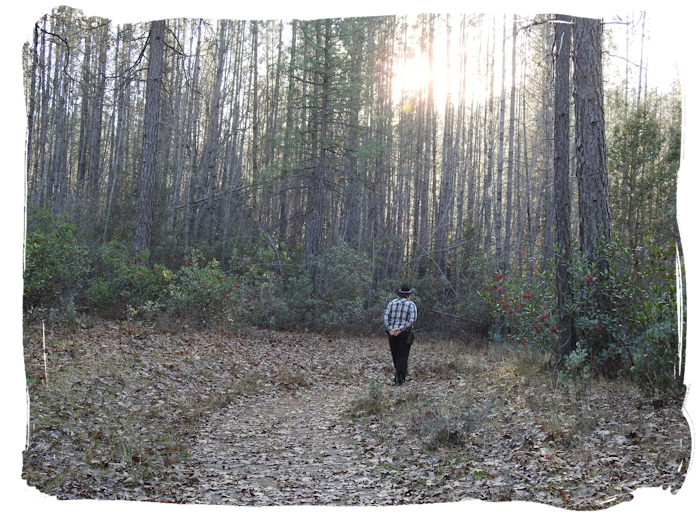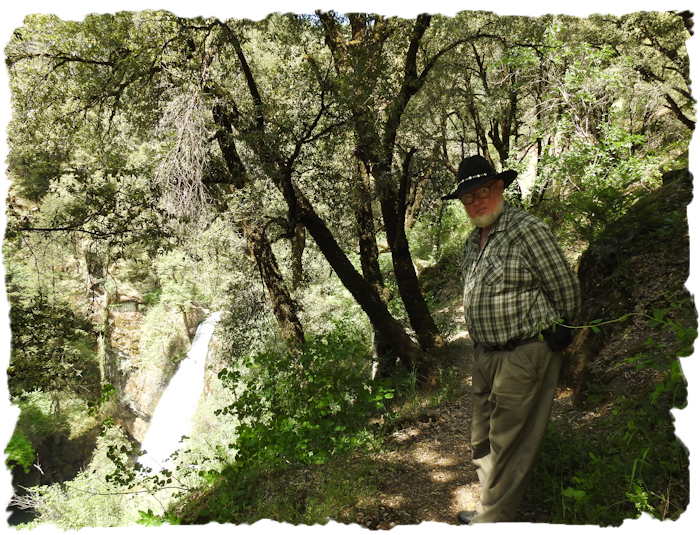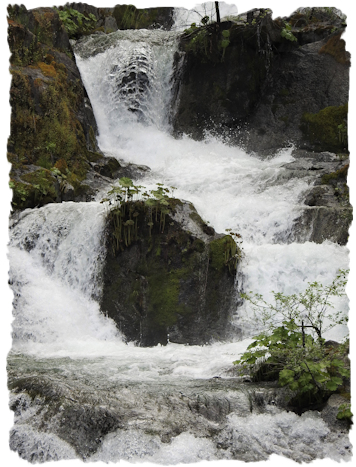HIKING USING A MOBILITY DEVICE
Thought for today: Philippians 4:8 ..Whatever is true, whatever is noble, whatever is pure, whatever is lovely, whatever is admirable - if anything is excellent or praiseworthy, think about such things..
Disclaimer: There is no assurance that any resource or activity I've found or described will be as 'accessible' as you might need. Information or links may be out of date. Use the information at your own risk and be sure to check with your health care professional for exercise advice.

From Shasta Trinity National Forest, 'We urge hikers and other backcountry users to be prepared. Carry a topographic map, compass and GPS and know how to use them. Pack gear and wear boots and clothing appropriate for a variety of conditions. Let someone know your plans and your back up plans! Always have a back-up plan in case of unexpected hazards, such as changes in weather, snow-covered trails that are hard to find, a creek that is running too high to cross safely, or a bridge being damaged. And as always, call the nearest Ranger Station before you go. Stations are generally not open on weekends, so be sure to call during the week.' Sage advice - follow it, even for a day hike!
My reason for 'hiking' any mountain trail is to photograph some wonderful scenery that can't be reached by any other means. If I had my wish, I'd prefer to ride a horse, but never mind.
Maybe you don't use a rolling walker or a wheelchair. Maybe you just need to use hiking poles, walking stick or forearm crutches. Your options for hikes are then even broader than mine. Take a look at all that Terry Craig, The Disabled Hiker is accomplishing. Terry has some great videos for problem solving adaptive hiking. Plus he has many gear reviews that might help anyone with mobility issues who want to hike far away places.
At this point in time, I need my WalknChair, which I refer to as 'Big Red'. Not only does it keep me out on trails, but it also acts as a seat and gear hauler. In a dicey situation it can double as a wheelchair, too. But it does limit what trails I can use.
Lesson learned: The first time I attempted an unrated trail with my 'Big Red' Walk'n'chair, I picked a destination that was WAY beyond my skills level with a mobility device. I really, really (REALLY) wanted to photograph a particularly popular local waterfall in spring 2017 when the water flow was fantastic. I went about 300 feet down the exceedingly difficult and too-narrow trail and decided going any farther would be an even bigger mistake. The trail incline was very steep. It eroded to about 6 inches in spots, and had a severe side-slope in those same narrow spots. I had vastly over-estimated my abilities to make the 1500 foot trip to the base of the falls with my rolling walker.

Fortunately, my husband accompanied me and with his help (and some rope I carry in my Walk'n'chair daypack) we both got out of the canyon safely. Note to self - getting a great photo is not worth falling off a cliff and having to be rescued, which was a distinctly possible outcome of that adventure.
 After that illuminating experience, I decided to re-start my hiking experiences with more conventional ADA wheelchair accessible trails before attempting unclassified trails. So, off to Whiskeytown National Recreation Area (west of Redding, California) which has two great wheelchair accessible trails, lovely waterfalls and a gorgeous lake. We took a picnic lunch and went for the walk to the waterfall at Crystal Creek. Great photos and a happy experience!
After that illuminating experience, I decided to re-start my hiking experiences with more conventional ADA wheelchair accessible trails before attempting unclassified trails. So, off to Whiskeytown National Recreation Area (west of Redding, California) which has two great wheelchair accessible trails, lovely waterfalls and a gorgeous lake. We took a picnic lunch and went for the walk to the waterfall at Crystal Creek. Great photos and a happy experience!
I find I need to match the trail to my level of hiking experience and physical abilities, then my gear to the trail. In trail selection I look for these factors: Is the location going to have a great photo opportunity? I want a destination worth the effort, because hiking with an all-terrain walker is an effort.
I look at the time of year. Some trails near Redding are really, really hot in the summer. Others lack shade. In general, I hike trails in low elevations during the winter months, and go to higher elevations as the year progresses.
I need to know how long is the trail distance round trip. I've found that walking about .75 mile or 1.5 miles round trip is about my maximum to enjoy the day. I like to know how steep is the grade or change in elevation over the distance. A large increase in elevation over a short distance will mean the trail gets pretty steep somewhere. A trail grade that is more than 5 percent can be very difficult to manage safely.
Trail width and trail surface matters. Is it wide enough for my mobility device the entire distance? Are there obstacles like rocks or roots in the trail surface? Width is crucial. The trail needs to be at least a good solid 30 inches or more wide the entire distance, particularly if your device doesn't fold or you can't stand and walk at all.
Is there handicap parking? What about an ADA accessible restroom? Note that it's not enough that the restroom has a wheelchair symbol, it needs to actually BE accessible. For some reason, agencies fail to notice that 6 inch drop of the slab the restroom is sitauted upon.
As a user of a rolling walker, I often can't go as far on a paved trail than a person using any type of wheelchair since wheelchairs roll and I walk. On a hard-packed surface, we might be able to go an equal distance. On a surface that is rougher, like gravel or dirt, I might have the advantage. And anyone with a powered mobility device will go farther than I can, particularly on the Sacramento River Trail.
You can have your hiking partner pre-scout unrated, unpaved trails for you. My spouse does that for me. We often carry simple walkie talkies and he goes ahead and reports problems while I take a rest (or stop to take pictures). Based on his report, I can then go forwards or stop where I am and turn back. Safety first!
Here's a success story about doing your homework when using adaptive gear in AZ to make an undoable hike, doable: Antelope Canyon, AZ
Hiking During Wildfire Season
Wildfire in California is a major concern from about June through December. When planning an outing, I take into account the location of any active wildfires, and the terrain I expect to hike in. In summer, higher elevations tend to be lower in fire danger due to higher moisture content in fuels. But late in the year, when we haven't had rain, all hiking areas can be potentially dangerous. It shouldn't stop you from enjoying the outdoors, but you do need plan your hike well, and have an evacuation plan. That's why we always carry paper maps and have basic evac gear in our vehicle.
Here are a couple of excellent articles about hiking during fire season: How to react to wildfires and What you should know about fire restrictions
Every year we see people die in the north state because they 'took a short hike' without carrying basics with them. By basics, I mean a little water, some food, a jacket, a small first aid kit. Wheelers need to carry a small tool kit as well. And your phone. While you may not get lost, you could get stuck somewhere unexpectedly - and that space blanket in your trail kit could come in handy! Don't forget a whistle! And remeber, cell service is spotty in the woods.
In case you think that only people with disabilities need safety tips for hiking, think again. Here is a great Tips list for solo female hikers that really applies to everyone who hikes. READ IT!
If you have an android 'smart phone' please load Cal-Fire's free App (Ready for Wildfire), and the apps for KRCR TV (Shasta County). That way you can check wildland fire and weather conditions and stay current with local news.
If you are unwisely hiking alone, (or travelling backroads alone) then consider getting a 'SPOT Gen3 Satellite GPS Messenger' or similar tracker. Since this tracker uses satellites not cell service, you can reach emergency responders, check-in with family or friends, share GPS coordinates and track your adventures, all at the push of a button. It's a little pricey at $150 plus an annual subscription, but less than the cost of being rescued, and even less than the cost of many cell phones.
And that pretty much says it all. Adaptive hiking can be great fun but it's not risk-free. Hiking with mobility challenges adds a separate layer of risk. You can take steps to minimize risks, and should have a back-up plan. Then head off for adventure! Don't forget your camera!
DISABILTY RIGHTS ISSUES WHILE HIKING
Do you plan on using a 'motorized' mobility device (like an electric wheelchair or mobility scooter) on trails? Are a person with a disability (handicap) parking placard? ADA Rules governing the use of a disabled person's Personal Mobility Device on public pedestrian trails and paths should permit you to use whatever you need to use, with or without an electric motor. Note that this legal allowance will NOT hold true for your companion.
If you are asked to leave a recreational area by someone official because of your use of a mobility device, take their name, then leave, and make your discrimintation complaints in writing to the agency involved and enclose a copy of the ADA rules on powered personal mobility devices. Agency staffers are NOT well trained on disability rights issues. I have seldom encountered any problems of this type on public lands, but it's best to be prepared. Be an advocate!
Current ADA rules for use of: Personal Mobility Devices
California Parks: Use of Other Power Driven Mobility Devices in California State Parks
DRAFT ACCESSIBLE TRAILS LIST PDF Here's a list of trails I haven't hiked as yet. Maybe you can get there first! Remember, these are possibilities for adaptive and wheelchair hiking, not certainties.
